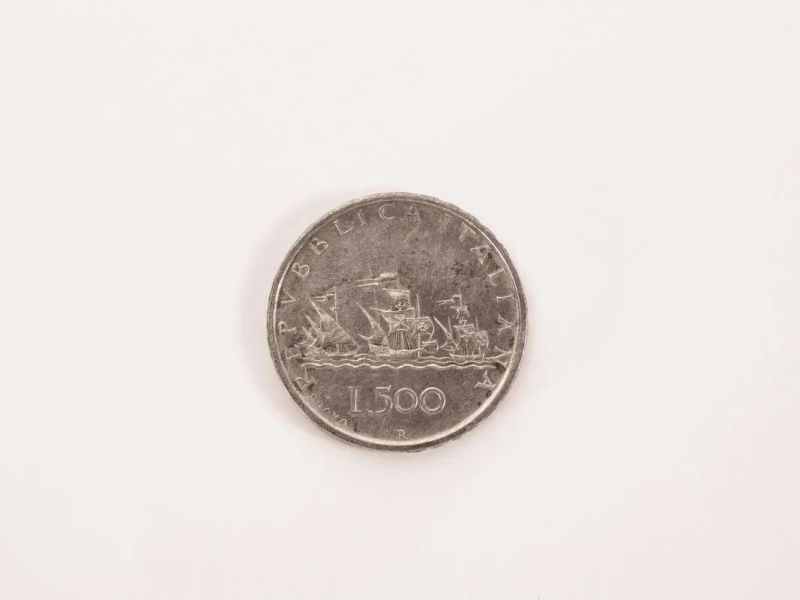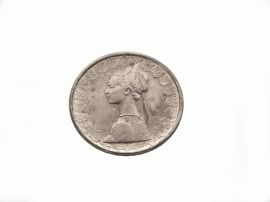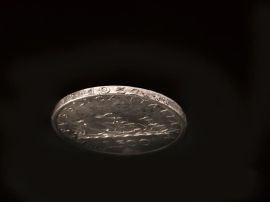REPUBBLICA ITALIANA, 500 LIRE PROVA, 1957
Diametro 29,5 mm, peso 11 grammi
Rarissima, argento 835/1000
1.070 pezzi coniati
conservazione quasi fior di conio
ITALIAN REPUBLIC, 500 LIRA PROOF, 1957
Diameter 29.5 mm, weight 11 grams
Very rare, 835/1000 silver
one of 1,070 pieces coined
condition: almost uncirculated
Fu per volere del Ministro del Tesoro Giuseppe Medici che la prima moneta della Repubblica Italiana, le 500 lire “Caravelle”, venne coniata dalla Zecca di Roma.
La realizzazione del modello venne affidata all’allora capo incisore della Zecca, Pietro Giampaoli, che per il diritto della moneta scelse un busto femminile di profilo abbigliato secondo la moda rinascimentale e circondato da stemmi di città e regioni italiane.
Se tale progetto fu ben accolto in quanto si adattava perfettamente, con il richiamo al Rinascimento e agli stemmi, al significato di “rinascita” cui la moneta voleva alludere, diverso esito ebbe la proposta di Giampaoli per il rovescio, per il quale aveva previsto una rosa.
Chiamati in causa altri incisori, a dimostrarsi all’altezza del compito fu Guido Veroi: per il verso delle 500 lire scelse le tre caravelle della scoperta dell’America, ricollegandosi così, rafforzandolo, all’intuitivo richiamo al Rinascimento già effettuato da Giampaoli nel diritto.
Subito approvata dal direttore della Zecca di Roma, la prova della moneta venne messa in atto a partire dal 1957, anno in cui uscirono 1.070 esemplari delle 500 lire, il cui successo di pubblico fu immediato: al diritto la moneta presentava una figura di donna abbigliata e pettinata alla moda rinascimentale, incorniciata da 19 stemmi e con il nome dell’incisore Giampaoli, mentre nel rovescio apparivano la Nina, la Pinta e la Santa Maria tra le onde del mare, con la scritta “REPUBBLICA ITALIANA” passante in alto e in basso il valore, “L. 500”, la sigla “R” della Zecca e l’indicazione “PROVA”; sul taglio, l’anno “1957”, in rilievo e circondato da 3 stelle.
La prova della nuova moneta era appena uscita che subito si accese intorno a essa una vera e propria querelle: a dicembre del 1957 il capitano di marina Giusco di Calabria sollevò il dubbio che le bandiere degli alberi maestri della Nina, della Pinta e della Santa Maria fossero state disegnate “controvento”. Attorno alla questione si scatenò un dibattito che vide impegnati molti specialisti del settore, scatenando addirittura la stampa locale; se alcuni sostenevano che le bandiere fossero disposte in maniera assolutamente sbagliata, altri ritenevano invece che la scena raffigurasse un altro metodo di navigazione, con il vento “a bolina”.
L’emissione della nuova moneta era tuttavia un avvenimento troppo importante perché si potesse rischiare di cadere in errore. Prima del conio ufficiale, il modello di prova venne quindi modificato, e nell’agosto del 1958 le 500 lire Caravelle entrarono in circolazione con le bandiere disposte in maniera tradizionale, rendendo così quei 1.070 esemplari di prova, con le bandiere “a rovescio”, un pezzo unico, ambito da ogni collezionista di numismatica.
It was Giuseppe Medici, the Minister of the Treasury, who decided that the first coin of the Italian Republic, the 500 lira “Caravelle”, should be minted in the Zecca of Rome.
The design was entrusted to the Chief Engraver in charge of the Zecca, Pietro Giampaoli, who for the front of the coin chose the bust of a woman in profile dressed in Renaissance style and surrounded by the coats of arms of Italian cities and regions.
This project, which was perfectly in line with the idea of “rebirth” that the coin wanted to allude to, thanks to its reference to the Renaissance and to the coats of arms, met a favourable reception: not so Giampaoli’s proposal for the reverse, where he had opted for a rose.
Other engravers were sent for, it was Guido Veroi who proved to be up to the task: for the reverse of the 500 lira coin he decided on the three caravels of the Discovery of America, thus recalling and reinforcing the intuitive connection with the Renaissance which Giampaoli had already achieved on the front.
Forthwith approved by the director of the Zecca of Rome, the production of the proof started in 1957, when 1,070 pieces of the 500 lira were released. The success with the public was immediate: on the front of the coin there was a female figure with Renaissance attire and hairstyle, encircled by 19 coats of arms and the engraver’s name Giampaoli, while the reverse showed the Niña, the Pinta and the Santa María riding the waves, with the words “REPUBBLICA ITALIANA” written around the top and the value “L. 500”, the abbreviation “R” of the Zecca and the indication “PROVA” below; on the rim, the year “1957” in relief with three stars on either side.
As soon as the proof of the new coin had been released, a real querelle sprung up around it: in December 1957 the captain of the Navy Giusco di Calabria raised the doubt that the flags on the mainmasts of the Niña, the Pinta and the Santa María had been drawn “upwind”. The issue sparked a debate which involved many experts in the field, unleashing even the local press; some asserted that the arrangement of the flags was totally incorrect, while others believed that the scene depicted a different way of sailing, “close to the wind”.
The issuing of the new coin was however too important an event to risk being mistaken. Before the official coinage, the proof was therefore modified, and in August 1958 the 500 lira Caravelle began circulating with the flags in the traditional position, making those 1,070 proofs with the flags “the wrong way round” unique, and sought-after by every coin collector.










